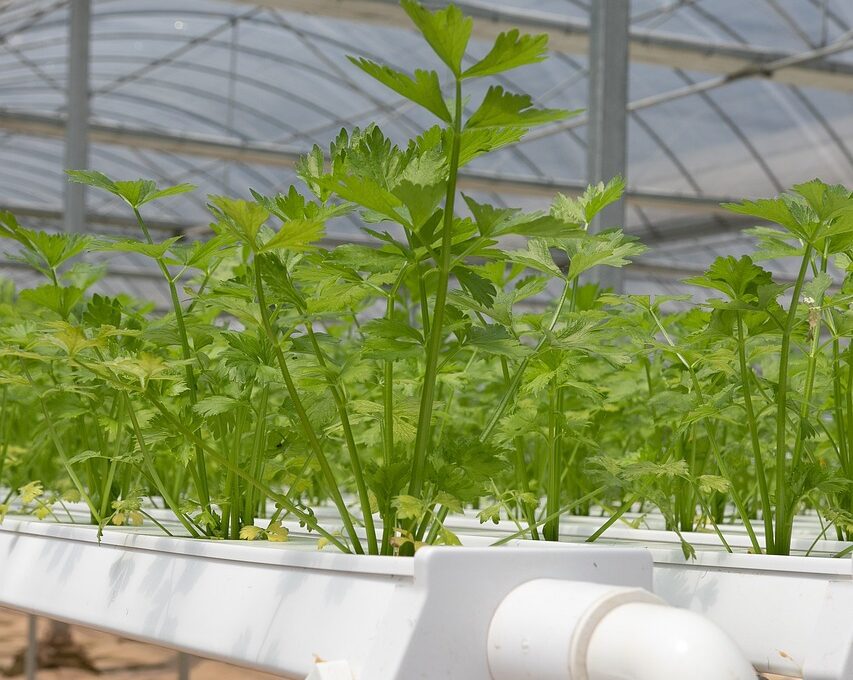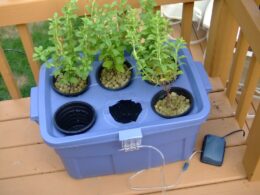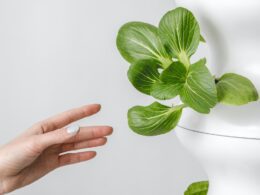Are you looking to start a hydroponic garden but worried about the risk of bacteria? It’s a valid concern as bacteria can quickly spread and damage your plants. In this article, we will explore some simple and effective ways to prevent bacteria in hydroponics.
Firstly, it’s essential to understand the risks associated with bacteria in hydroponics. Plants grown in a hydroponic system are susceptible to bacterial infections due to the high moisture levels and lack of soil. This can lead to root rot, which can be fatal to your plants.
However, with proper preventative measures and good hygiene practices, you can significantly reduce the risk of bacterial infections and ensure your hydroponic garden thrives. Keep reading to learn more!
Understand the Risks of Bacteria in Hydroponics
To successfully cultivate a flourishing hydroponic garden, it’s imperative that you comprehend the potential sources and risks of bacterial contamination. While beneficial bacteria can promote plant growth and development, harmful bacteria can stunt growth, reduce yield, and even lead to plant death.
Therefore, it’s crucial to implement preventive measures to avoid bacterial contamination in your hydroponic system. Comparing the bacterial risks in hydroponics versus soil-based growing, it’s important to note that hydroponic systems are more susceptible to bacterial growth due to their closed environment. In contrast, soil-based growing allows for more natural bacterial diversity and regulation. However, hydroponics offer the advantage of precise nutrient control and reduced pest and disease risks.
Understanding the risks and benefits of each growing method can help you decide which system is best for your needs. To reduce the risk of bacterial contamination in your hydroponic system, you can implement several preventive measures. These include regular system maintenance, proper disinfection of equipment and surfaces, and using sterile growing media.
Additionally, incorporating beneficial bacteria, such as those found in compost tea or other organic fertilizers, can help prevent the growth of harmful bacteria. With proper precautions, you can enjoy a thriving hydroponic garden without the risk of bacterial contamination.
Maintain a Clean Growing Environment
Keep your hydroponic system free from contaminants by regularly cleaning and sanitizing all surfaces and equipment. This ensures a safe and healthy environment for your plants to thrive in. Effective cleaning and sterilization techniques are essential to maintaining a clean growing environment.
Use a bleach solution or a hydrogen peroxide-based cleaner to sanitize surfaces. Make sure to rinse thoroughly with clean water. Proper air ventilation and circulation are also important in preventing the growth of harmful bacteria in your hydroponic system.
Make sure your grow room has adequate air flow and invest in a quality air filtration system to remove any airborne contaminants. Keep the temperature and humidity levels consistent, as fluctuations can create ideal conditions for bacteria growth. Regular maintenance and monitoring of your hydroponic system is crucial in preventing the spread of bacteria.
Check your water quality daily and adjust nutrient levels as needed. Keep an eye out for any signs of pests or disease, and address them immediately. By taking these preventative measures, you can ensure a healthy and vibrant hydroponic garden.
Implement Proper Nutrient Management
Proper nutrient management is key to maintaining a thriving hydroponic garden, so it’s important to regularly monitor and adjust nutrient levels to ensure your plants are getting the right balance of nutrients. Nutrient balance is crucial because too much or too little of certain nutrients can cause stunted growth, leaf yellowing, or even death of your plants.
The pH levels of the nutrient solution should also be monitored to ensure that the plants can absorb the nutrients they need. To maintain nutrient balance, you should test your nutrient solution regularly using a pH meter and a nutrient testing kit. Adjust the nutrient levels as needed to keep the pH in the desired range for your plants.
Different plants have different nutrient requirements, so make sure to research the specific needs of the plants you’re growing to ensure they get the optimal amount of nutrients. Over-fertilizing can be just as harmful as under-fertilizing, so it’s important to find the right balance.
Proper nutrient management not only helps prevent harmful bacteria growth, but it also ensures that your plants are healthy and productive. By monitoring and adjusting nutrient levels and pH, you can prevent nutrient deficiencies and excesses that can lead to a weakened immune system in plants.
Healthy plants are less susceptible to disease and pests, making nutrient management an essential part of maintaining a safe and thriving hydroponic garden.
Practice Good Hygiene
Make sure you’re taking care of your plants by keeping your hydroponic system clean and free of any potential sources of contamination. Practicing good hygiene is an essential step to prevent the growth of harmful bacteria in your hydroponic setup. Cleanliness is paramount not only for the health of your plants but also for yours.
One of the benefits of good hygiene is that it helps to prevent the spread of diseases between plants. Keep your hydroponic system clean by disinfecting any tools or equipment that you use, such as scissors or grow trays, before and after use. Additionally, make sure to clean your hands thoroughly before handling your plants.
Consistency is another vital aspect of good hygiene. By making sure to maintain a consistent cleaning schedule, you can ensure that your hydroponic system is always free of harmful bacteria.
Incorporate good hygiene practices into your daily routine to prevent bacteria from taking hold in your hydroponic system. By avoiding cross-contamination, regularly cleaning, and practicing good hygiene, you can promote healthy plant growth and ensure that your produce is free of harmful bacteria.
Remember, the benefits of hygiene are essential to the success of your hydroponic garden, so make sure to stay consistent with your cleaning schedule to keep your plants and yourself healthy.
Monitor and Respond to Signs of Bacterial Infection
You need to be able to recognize the symptoms of bacterial infection in your hydroponic plants in order to effectively maintain their health.
If any plants show signs of infection, it’s important to isolate them from the others to prevent the spread of bacteria.
Finally, you should use appropriate treatment methods to eliminate the bacteria and prevent further damage to your plants.
Recognize Symptoms of Bacterial Infection
If you notice any unusual changes in your plants, such as discoloration or wilting, it’s possible that they may be experiencing a bacterial infection. It’s important to recognize the symptoms of bacterial infection early on to prevent it from spreading and causing irreversible damage.
Early detection is key to effective treatment, and being proactive can save you time, money, and effort in the long run. Some common symptoms of bacterial infection in hydroponics include yellowing or browning of leaves, stunted growth, root rot, and a foul odor. If you notice any of these symptoms, it’s important to act quickly.
Preventive measures such as maintaining a clean growing environment, using sterilized equipment, and using beneficial bacteria can help reduce the risk of bacterial infection. Taking a proactive approach to monitoring your plants and responding to any signs of infection can help ensure a healthy and successful hydroponic system.
Isolate Infected Plants
To effectively control the spread of bacterial infection in your hydroponic system, it’s essential to isolate any infected plants as soon as possible. This will prevent the bacteria from spreading to other plants and causing a full-blown outbreak.
Here are some steps you can take to isolate infected plants and prevent the spread of bacteria:
- Remove the infected plant from your hydroponic system immediately.
- Dispose of the plant properly to prevent the bacteria from spreading.
- Quarantine any nearby plants to prevent the bacteria from spreading to them.
- Clean and sanitize the area where the infected plant was located to remove any remaining bacteria.
By following these plant disposal and quarantine procedures, you can effectively prevent the spread of bacteria in your hydroponic system and keep your plants healthy. Remember, prevention is key when it comes to bacterial infections, so act fast and take immediate action when you notice any symptoms.
Use Appropriate Treatment Methods
It’s essential to use appropriate treatment methods to effectively control bacterial infections in your hydroponic system and keep your plants healthy.
Hydroponic farming offers many benefits, including higher yields and more efficient use of resources. However, these benefits can be compromised if bacterial infections are allowed to take hold in your system.
Maintaining a proper pH balance is crucial in hydroponics, as it can prevent the growth of harmful bacteria. A pH level of 5.5 to 6.5 is optimal for most hydroponic plants and can help keep your system free from harmful bacteria.
In addition to maintaining proper pH levels, there are various treatment methods you can use to prevent bacterial infections in your hydroponic system. One effective method is to use beneficial bacteria, such as Bacillus subtilis, which can help outcompete harmful bacteria and prevent them from taking hold.
Another method is to use hydrogen peroxide, which can be added to the nutrient solution to kill off harmful bacteria. By using these appropriate treatment methods, you can ensure that your hydroponic system remains healthy and productive.
Frequently Asked Questions
What are some common types of bacteria that can infect hydroponic systems?
Common bacteria in hydroponics can pose a serious threat to the health of your plants. Some of the most common types of bacteria that can infect hydroponic systems include Pseudomonas, Erwinia, and Xanthomonas.
However, there are several prevention measures you can take to keep your hydroponic system free of harmful bacteria. One of the most important prevention measures is nutrient solution management. This involves regularly monitoring the nutrient solution to ensure that the pH and nutrient levels are optimal for plant growth.
Additionally, you can reduce the risk of bacterial contamination by sterilizing all equipment before use and maintaining a clean growing environment. By implementing these measures, you can help ensure the health and safety of your hydroponic plants.
Can using certain types of nutrient solutions increase the risk of bacterial infection in hydroponics?
Using certain types of nutrient solutions can increase the risk of bacterial infection in hydroponics. Additives such as enzymes can affect bacterial growth and, if not properly sterilized, can lead to the growth of harmful bacteria. Therefore, it’s important to use proper sterilization techniques in hydroponic nutrient solutions to prevent the growth of harmful bacteria.
To ensure the safety of your hydroponic system, make sure to regularly test and monitor your nutrient solutions. Additionally, use sterilization techniques such as UV sterilization or ozone treatment. By taking these precautions, you can prevent bacterial infections and ensure the health of your plants.
How often should the pH and nutrient levels in a hydroponic system be checked to prevent bacterial growth?
To maintain a healthy hydroponic system and prevent bacterial growth, it’s important to regularly test the pH and nutrient levels. The optimal frequency of testing depends on the specific system and plants, but a good rule of thumb is to check every 1-2 weeks.
There are several testing methods available, including pH meters and nutrient test kits. In addition to monitoring levels, it’s crucial to ensure proper ventilation and high-quality water.
Adequate airflow helps prevent stagnant air that can harbor bacteria, while using purified or filtered water minimizes the presence of harmful organisms. By staying on top of pH and nutrient levels, as well as maintaining good ventilation and water quality, you can help keep your hydroponic system bacteria-free and your plants healthy.
Is it possible to completely eliminate the risk of bacterial infection in hydroponic systems?
To completely eliminate the risk of bacterial infection in hydroponic systems, preventing contamination and sterilization are key. It’s important to start with a clean system and maintain good hygiene practices, such as washing hands before handling plants and equipment.
Regularly sterilizing the system, including the growing medium and any tools used, can also help prevent the growth of harmful bacteria. Additionally, monitoring nutrient and pH levels and making adjustments as needed can ensure that the system is not providing an environment conducive to bacterial growth.
While it may not be possible to completely eliminate all risk of bacterial infection, taking these precautions can greatly reduce the chances of contamination in your hydroponic system.
Are there any natural remedies or organic methods for preventing or treating bacterial infections in hydroponics?
Looking for natural remedies for hydroponic bacteria or organic solutions for bacterial infections in your hydroponic system? Fortunately, there are several options available to you.
One of the most effective is to use beneficial microorganisms such as Bacillus subtilis, which can help to crowd out harmful bacteria and boost the overall health of your plants.
Another option is to use essential oils, which have natural antimicrobial properties that can help to prevent the growth of harmful bacteria.
Additionally, using hydrogen peroxide or vinegar can help to disinfect your system and prevent the growth of harmful bacteria.
By utilizing these natural and organic solutions, you can keep your hydroponic system free from harmful bacterial infections and ensure the health and safety of your plants.
Conclusion
Congratulations! You now know how to prevent bacteria in your hydroponic system.
Remember, a clean and sterile growing environment is key to keeping harmful bacteria at bay. It’s important to maintain proper nutrient management to prevent the buildup of harmful bacteria in your hydroponic system.
Lastly, always practice good hygiene, such as washing your hands and wearing gloves when handling plants or equipment.
To ensure that your hydroponic system stays healthy, it’s important to monitor for signs of bacterial infection and respond quickly if you notice any issues.
With these tips, you can maintain a thriving and bacteria-free hydroponic system that will yield healthy and nutritious plants for years to come.
Keep up the good work and happy growing!








